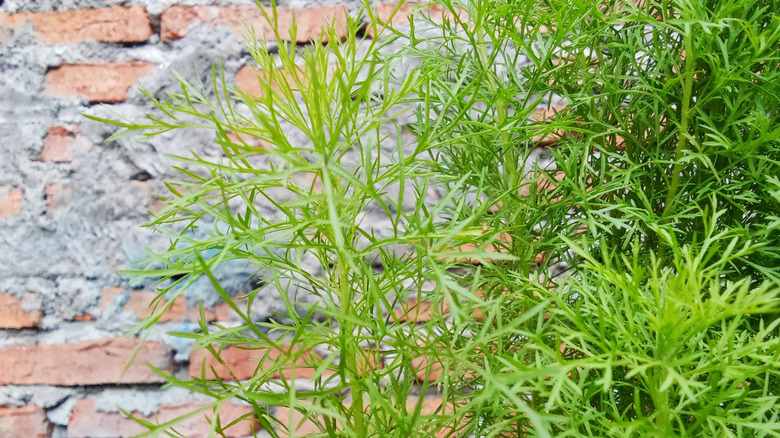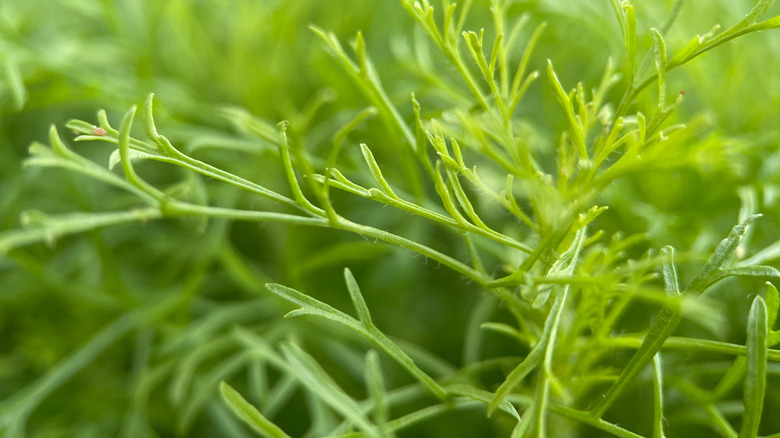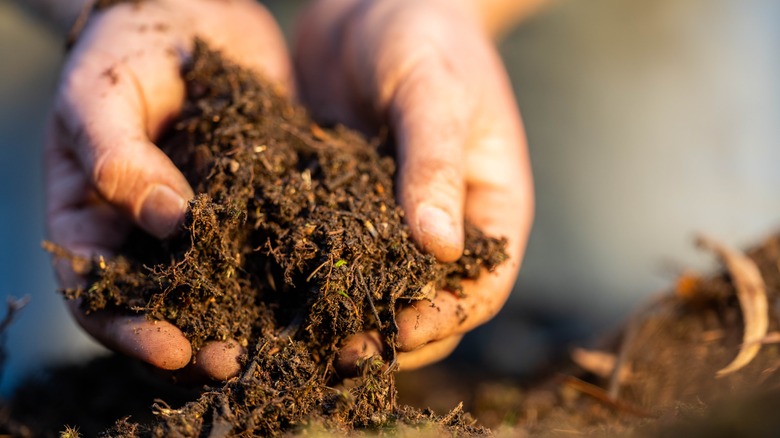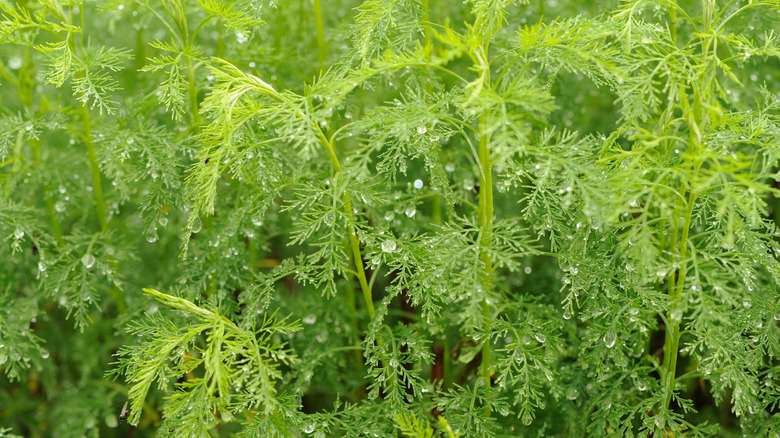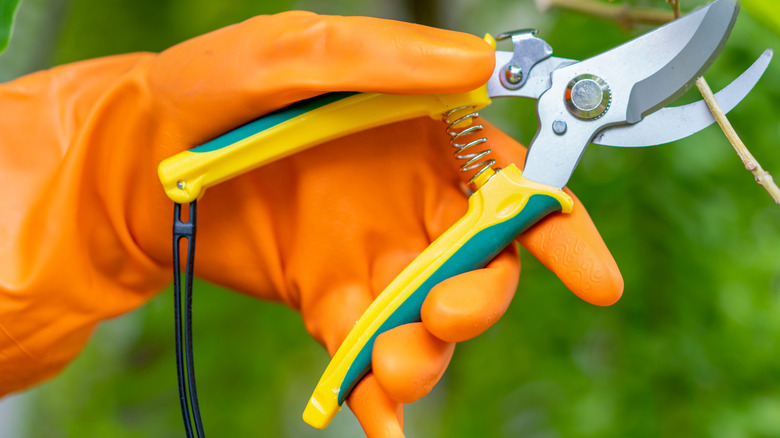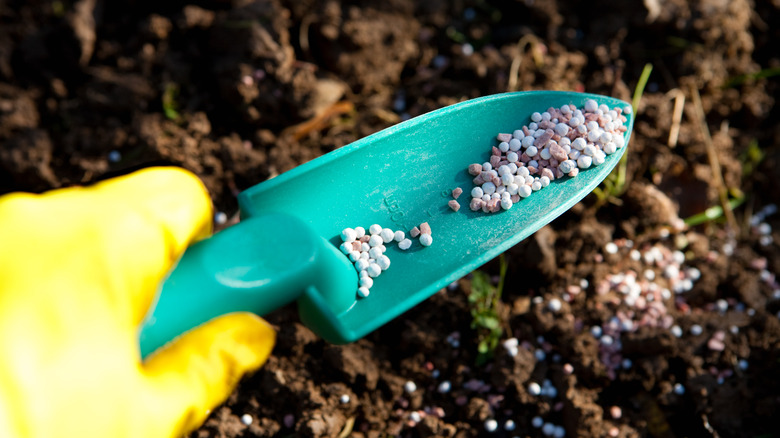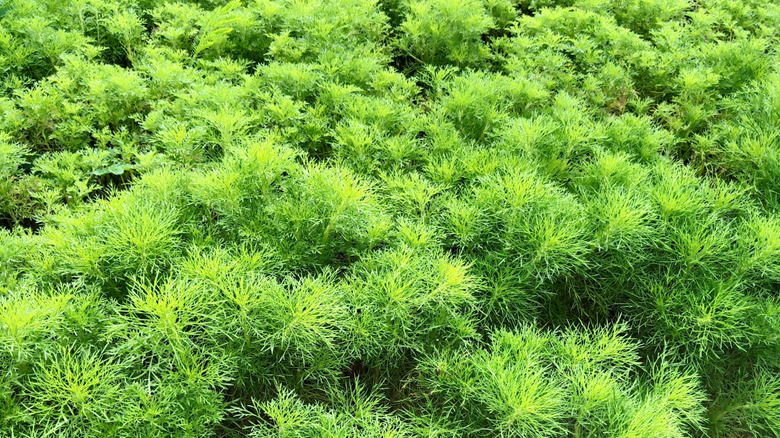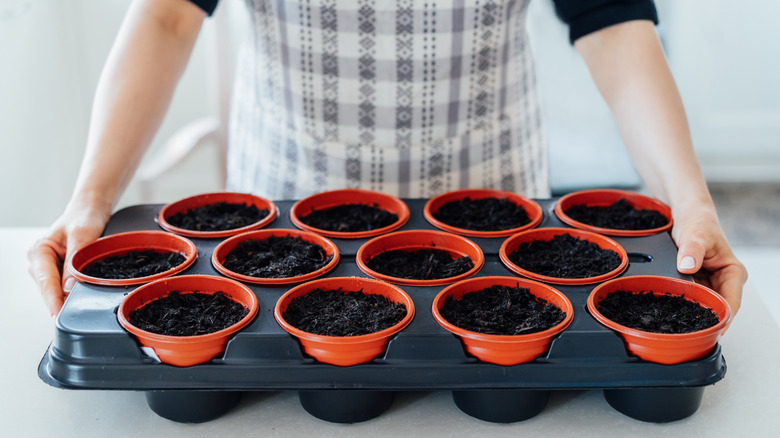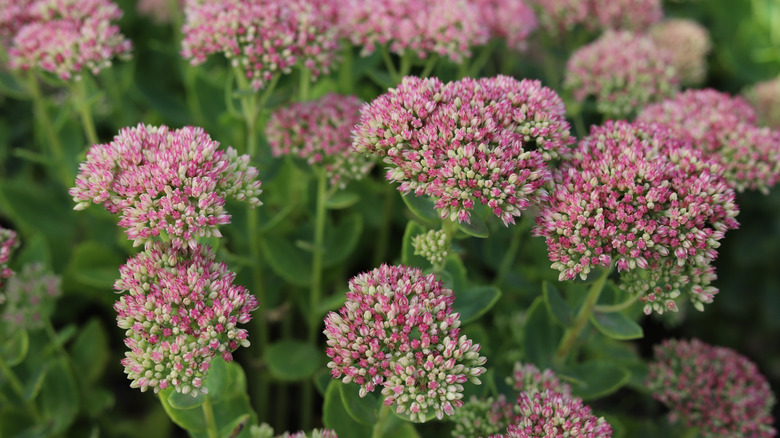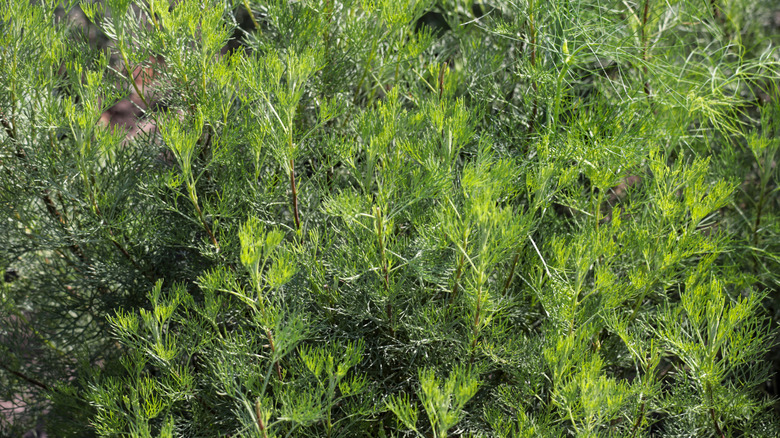Everything To Know About Planting Southernwood, A Perennial Favorite
Ever since settlers first planted southernwood (Artemisia abrotanum) in New York in the 1700s, it has become a perennial favorite for many American gardeners. With its highly dissected, soft green, fern-like foliage that sways with the breeze and shimmers as it catches the late afternoon sun, it adds a feathery touch to gardens. Since its leaves emanate a zesty citrusy-camphor fragrance, cultivating southernwood is a wonderful way to enhance your garden's sensory appeal. Besides, if you're a believer in the old-school way to keep your home smelling fresh, you can harvest and dry its leaves to make aromatic potpourris and sachets. Or, even better, weave its blades into herb wreaths or floral arrangements.
Going by the names of maid's love, garderobe, sitherwood, and old man, southernwood blooms white or green-toned, cup-shaped golden flowers from August through October. The eastern U.S. is the exception to the rule, where it's more of a rarity to find southernwood in flower. While the blossoms don't exactly scream "spectacular," despite coming from the gorgeous Asteraceae (daisy) family, butterflies adore them nonetheless. Notwithstanding its Mediterranean heritage, southernwood also doesn't feature on any invasive lists. The NC State Extension says southernwood has the potential to turn weedy and establish in disturbed sites, however, EcoFloras of North America says that such claims may be exaggerated. So whether or not southernwood will turn weedy is up for debate, but even established plants are relatively easy to remove should the need ever arise. Ready to plant southernwood in your yard? Read on to learn about its other features and cultural requirements.
Southernwood prefers full sun exposure and dry heat
As is common with most Mediterranean herbs, southernwood prefers sites that receive direct sunlight for a minimum of six hours. That's because the aromatic herbs can't develop their oils otherwise. Another reason to maintain full sun exposure is that with increased shade, the bushes can turn wiry and sprawling, as they tend to maintain open centers. This makes the perennial look weedy instead of ornate. That being said, artemisia plants can withstand light shade in extreme circumstances.
Moreover, southernwood favors dry site conditions over wet. Despite its name, it's not likely to love the humid conditions common to southern states, limiting its adaptability to USDA hardiness zone 8. The plant is cold-hardy, allowing it to potentially survive down to zone 4. Protect its roots with mulch throughout the year, and ensure southernwood plants aren't exposed to high winds, or the delicate foliage will get damaged.
Southernwood can adapt to most soils, provided they drain well
Southernwood is known for being unfussy about most soil conditions, though still favoring those on the drier side. As long as the pH levels hover between 6.1 and 7.8, the citrus-scented perennial will thrive in both mildly acidic and alkaline soils. But if you wish to be a stickler for "right conditions," pop them in near-neutral soils (close to 6.7 on the pH scale). Similarly, southernwood plants readily adapt to different soil textures from loamy to sandy. They're also one of the best plants to grow in shallow soil.
However, to ensure your southernwood's foliage looks its best throughout the year, the site must offer good drainage. Like most herbs, southernwood has poor tolerance for wet conditions and can start rotting if its feet remain in standing water for extended durations. If you struggle with heavy or waterlogged soil in your garden, you can try planting southernwood specimens in raised beds so that drainage remains on point. Another option is to incorporate a 2- to 3-inch-thick layer of compost to improve the drainage of heavy clay soils in your garden — your southernwood sub-shrub will enjoy the organic boost as well.
Mature southernwood plants don't have any major watering demands
Ornamental beauty aside, another reason southernwood is experiencing a renaissance of sorts in the planting world is because of its drought tolerance. Since it demonstrates a remarkable tolerance for dry soils, it's highly sought-after by waterwise gardeners and those practicing the xeriscaping trend. If your gardening activities are constrained by your state's water restrictions, you'll cherish the opportunity to maintain ornamental shrubs without using supplemental irrigation. Weekly watering in the most severe droughts keeps southernwood sated. This explains why it is often planted in dry, sunny, and rocky sites (where most plants usually struggle to establish themselves) — and even around tall trees.
However, keep in mind that this drought tolerance kicks in only after the plants have established themselves completely in their designated sites. Until then, young southernwood specimens must be thoroughly watered to encourage growth, while ensuring the soil doesn't dry out completely in between soakings. Also, try to water during the day to give the foliage sufficient time to dry off, or your southernwood plants can become susceptible to rot and foliage diseases. Laying down a 1- to 2-inch-thick layer of pea gravel around the herb should also help increase moisture retention.
Southernwood should be cut back every spring
When southernwood has exhausted its muted yellow blooms around mid-summer, its low-growing clump often begins assuming a weedy appearance. Its stems grow bare at the lower sections, looking gangly, woody, and unkempt. However, if you cut back the plant to the ground, it will grow sturdy new shoots in the spring, ultimately adopting a bushier mien. But since southernwood maintains a semi-evergreen outlook in areas with frost-free winters, it's best to push such shearing activities to early spring (right when forsythias are actively putting out a show).
If you want to save and dry what you trim off, before pruning southernwood, lay down a sheet around its base to collect the snipped stems. With a pair of pruning shears, shear back the plant to between 6 and 9 inches. Also, remove any weathered or thinning stems. Ideally, it's safe to remove ⅓ of the total growth without risking the plant's health. Clean up the debris and freshen the mulch layer. Remember, southernwood responds well to severe pruning and will quickly re-green. So, if you wish to shape it into a compact, rounded mound, you can safely trim its stems every month. However, refrain from pruning around eight weeks before the first expected frost.
Southernwood doesn't require frequent fertilization
Keeping in line with the usual norm of herbs, southernwood is one of those conveniently low-maintenance plants you don't have to fertilize. It likes high organic matter content in soils, which you can easily meet through compost and mulch applications. Other than that, it's best to get a soil test done before feeding these herbaceous perennials anything stronger.
Going overboard with fertilizers usually works contrarily with aromatic herbs, as it promotes lush foliage growth, but at the cost of flavor and fragrance. Not to mention, the leaves often flop over, making for a poor visual aesthetic. Besides, southernwood typically tends to grow bushy and even returns quickly after a stern pruning, making the whole fertilization routine unnecessary. This is also why it's so successful in lean soils. However, if you feel your plant is showcasing very slow growth, or a soil test reveals serious deficiencies, you can apply a small amount of balanced granular fertilizer to its base in early spring or right after pruning.
Southernwood should be divided every few years
After a while, perennial artemisia plants with an upright or mounding habit tend to start dying out at their centers. Simply put, their foliage grows strawy and discolored at the main base, necessitating periodic division. To prevent this, aim to separate the clumps every three to four years. This way, the herbs will continue to push out vigorous growth, reliably returning year after year.
Another advantage of periodic division is that you can propagate new plants or earn brownie points with friends looking to grow low-maintenance species. To divide southernwood successfully, first ease out the entire clump from the ground. Follow up by splitting apart its fibrous roots around the middle (dead) section — ensuring each divided piece has some healthy leaves on it. You can also slice through the southernwood plant with a shovel. Replant the sliced parts elsewhere in the yard. Don't forget to give the new plants a deep soaking to promote quick rooting. Division can be carried out during spring or fall.
Southernwood can be easily propagated
Being easy to propagate is another reason for southernwood's popularity among gardeners. Aside from division, this perennial herb can also be grown through semi-hardwood stem cuttings. Around late summer, simply select a new stem (not old growth) and clip it right below a node (where a leaf is coming out of the stem). Ensure the cutting is roughly 5 inches long and contains more than two nodes. Remove all the lower leaves from the cutting. Next, apply a rooting compound to the cut point, or the semi-hardwood cutting will take significant time to root itself. Place the cuttings in small nursery pots or growing trays, with a couple of the growth nodes below the soil. Ensure the soil remains moist and warm. You should see new growth and roots within six weeks.
Alternatively, southernwood can be propagated using seeds. However, as mentioned earlier, this perennial barely flowers in the northern range. When it does, it's late into the growing season, which deprives the seeds of adequate time to fully ripen. That's why southernwood typically doesn't produce many viable seeds to begin with (and so doesn't take over the garden either). In case you do find some mature seeds, save them in the fall and sow in the spring. They should germinate in less than three weeks.
What to plant with southernwood
There are plenty of ways you can incorporate southernwood into your landscape. As the herb doesn't grow taller than 4 feet and extends only 3 feet across, it serves as a small sub-shrub that's perfect for filling in gaps in the garden. Some gardeners like to use southernwood in vegetable patches, planting it in rows between cabbages or cauliflowers. Apparently, this perennial herb may help to deter certain insects and moths through its smell, potentially benefiting adjoining plants, such as pear and apple trees. You can even try keeping pesky ticks at bay with the help of this beautiful plant, as they reportedly dislike absinthol, a ketone present in the herb's fragrant oils (just be sure to pair this with other anti-tick strategies, as having a couple of southernwood plants is unlikely to render your yard tick free). Its compact stature also makes southernwood an ideal fit for the middle of border beds where its delicate foliage adds texture and interest. It can also complement slightly gray-hued species such as sedums and alliums. You can even prune it into rounded topiary-type shapes and use it to edge garden paths and walkways to enjoy its lemony or camphor-like fragrance.
A classic way to feature southernwood in your garden is to team up it with other Mediterranean herbs. Naturally, they must enjoy the same growing conditions, like full-to-part sun and well-draining soils. Generally, lavender, basil, rosemary, and sage get along with southernwood, especially in herb planters. If you're planning a rock garden theme, creeping phlox and rock cress can serve as suitable plants to pair with southernwood.
Southernwood is deer- and rabbit-resistant
Another valuable thing to know about southernwood is that it's resistant to being eaten by deer and rabbits. If your garden is regularly raided, then you're probably all too well aware that there aren't any guarantees when it comes to what plants these "visitors" won't eat. However, thanks to its strong smell, southernwood is regularly listed as a perennial that's less likely to get munched by rabbits or deer.
The leaves' bitter taste probably plays a role in making southernwood plants unappealing to rabbits and deer, and all of its parts, including bark, foliage, stems, seeds, roots, and flowers, contain a chemical called thujone — the compound behind the herb's sharp fragrance — which can be toxic if ingested in large quantities. So if you're hunting for perennials that are less likely to get mown down by hungry garden guests, southernwood is a great choice. At the same time, keep in mind its potential toxicity in relation to your own household and site the plant accordingly (although the unpleasant taste is usually repugnant enough to discourage ingestion).
Southernwood offers diverse varieties and cultivars
Apart from the straight species, southernwood also offers a plethora of diverse varieties. For instance, if you'd prefer a comparatively larger specimen to fit at the back of your garden's borders, look for tangerine southernwood (Artemisia abrotanum 'Tangerine'). It grows up to 6 feet and supports tangerine-smelling, semi-evergreen plumose foliage. It's cold hardy only up to zone 5 but can be popped into containers if desired. In contrast, if you're looking for a low-growing variety that's tolerant of a wide spectrum of light conditions from direct sun to full shade, consider leprechaun southernwood (Artemisia abrotanum 'Leprechaun'). It's quite compact, growing no higher than 3 feet, with 2 feet being the average in most areas, and spanning the same width. It's also suitable for alpine gardens, as it can survive in elevated heights.
Silver southernwood (Artemisia abrotanum 'Silver') is another compact contender for your garden. It puts forth silverish-green foliage and tops out at 3 feet. While it doesn't flower as much, it can survive in zones 5-11. Cola plant (Artemisia abrotanum var. maritima) may be your true calling if you're sick of citrus fragrances and prefer your garden (and your fingers) smelling of soda. It grows 2 feet top and across, is hardy to 5 degrees Fahrenheit, but tends to be short-lived.
